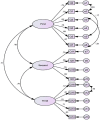Psychometric evaluation of the Persian version of the diabetic foot self-care questionnaire in Iranian patients with diabetes
- PMID: 33865367
- PMCID: PMC8052781
- DOI: 10.1186/s12902-021-00734-5
Psychometric evaluation of the Persian version of the diabetic foot self-care questionnaire in Iranian patients with diabetes
Abstract
Background: Diabetic foot self-care refers to a group of self-management behaviors that can reduce the incidence of foot ulcers and amputations. It is necessary to have a valid and reliable standard tool to measure foot self-care in diabetic patients. This study aimed to evaluate the psychometric properties of the Persian version of the Diabetic Foot Self-Care Questionnaire of the University of Malaga, Spain (DFSQ-UMA) in Iran.
Methods: This cross-sectional study was conducted with 407 diabetic patients who were selected using a convenient sampling method. Construct validity was assessed by exploratory (with 207 patients) and confirmatory (with 200 patients) factor analyses. Internal consistency was calculated using Cronbach's alpha and McDonald's omega coefficients.
Results: In the exploratory factor analysis, three factors with eigenvalues of 3.84, 2.41, and 2.26 were extracted that together explained 56.74% of the total variance of diabetic foot self-care. A Cronbach's alpha of 0.865 was found for the total instrument.
Conclusions: The Persian version of the DFSQ-UMA has good validity and reliability, and given its good psychometric properties, it can be used in future studies.
Keywords: Diabetes; Diabetic foot; Diabetic foot self-care; Psychometrics; Self-care.
Conflict of interest statement
The authors declare that they have no competing interests.
Similar articles
-
Development, validation and psychometric analysis of the diabetic foot self-care questionnaire of the University of Malaga, Spain (DFSQ-UMA).J Tissue Viability. 2015 Feb;24(1):24-34. doi: 10.1016/j.jtv.2014.11.001. Epub 2014 Nov 27. J Tissue Viability. 2015. PMID: 25523014
-
Psychometric evaluation of the Farsi version of the diabetes foot self-care bahavior scale.J Foot Ankle Res. 2020 Nov 30;13(1):68. doi: 10.1186/s13047-020-00437-5. J Foot Ankle Res. 2020. PMID: 33256822 Free PMC article.
-
Reliability and validity of the Diabetic foot self-care questionnaire in Turkish patients.Prim Care Diabetes. 2023 Oct;17(5):513-517. doi: 10.1016/j.pcd.2023.06.005. Epub 2023 Jun 9. Prim Care Diabetes. 2023. PMID: 37302937
-
Validation of the Persian version of the summary of diabetes self-care activities scale (SDSCA) in pregnant women with gestational diabetes mellitus using a COSMIN methodology.BMC Endocr Disord. 2025 Apr 18;25(1):103. doi: 10.1186/s12902-025-01931-2. BMC Endocr Disord. 2025. PMID: 40251509 Free PMC article.
-
Diabetic foot ulcer self-care assessment: a scoping review.Rev Bras Enferm. 2023 Aug 7;76(3):e20220555. doi: 10.1590/0034-7167-2022-0555. eCollection 2023. Rev Bras Enferm. 2023. PMID: 37556696 Free PMC article.
Cited by
-
Economic burden of diabetic foot ulcer: a case of Iran.BMC Health Serv Res. 2024 Mar 21;24(1):363. doi: 10.1186/s12913-024-10873-9. BMC Health Serv Res. 2024. PMID: 38515182 Free PMC article.
-
Exploring the Relationship of Health Beliefs and Self-Care Behaviors Related to Diabetic Foot Ulcers of Type II Diabetes Mellitus Patients: A Cross-Sectional Study.Int J Environ Res Public Health. 2021 Jul 5;18(13):7207. doi: 10.3390/ijerph18137207. Int J Environ Res Public Health. 2021. PMID: 34281144 Free PMC article.
-
Assessing the effectiveness of targeted educational interventions on enhancing self-efficacy and foot care practices among diabetic women in Jordan.Front Public Health. 2025 Jan 7;12:1502781. doi: 10.3389/fpubh.2024.1502781. eCollection 2024. Front Public Health. 2025. PMID: 39839435 Free PMC article.
-
Validity and reliability of the English version of the Diabetic Foot Self-Care Questionnaire: a cross-cultural adaptation.Front Public Health. 2024 Jan 24;11:1326439. doi: 10.3389/fpubh.2023.1326439. eCollection 2023. Front Public Health. 2024. PMID: 38332943 Free PMC article.
References
-
- Quandt SA, Reynolds T, Chapman C, Bell RA, Grzywacz JG, Ip EH, Kirk JK, Arcury TA. Older adults’ fears about diabetes: using common sense models of disease to understand fear origins and implications for self-management. J Appl Gerontol. 2013;32(7):783–803. doi: 10.1177/0733464811435506. - DOI - PMC - PubMed
-
- Bradbury SE, E Price P. Diabetic foot ulcer pain: the hidden burden (part two) EWMA J. 2011;11(2):25–37.
Publication types
MeSH terms
Grants and funding
LinkOut - more resources
Full Text Sources
Other Literature Sources
Medical


